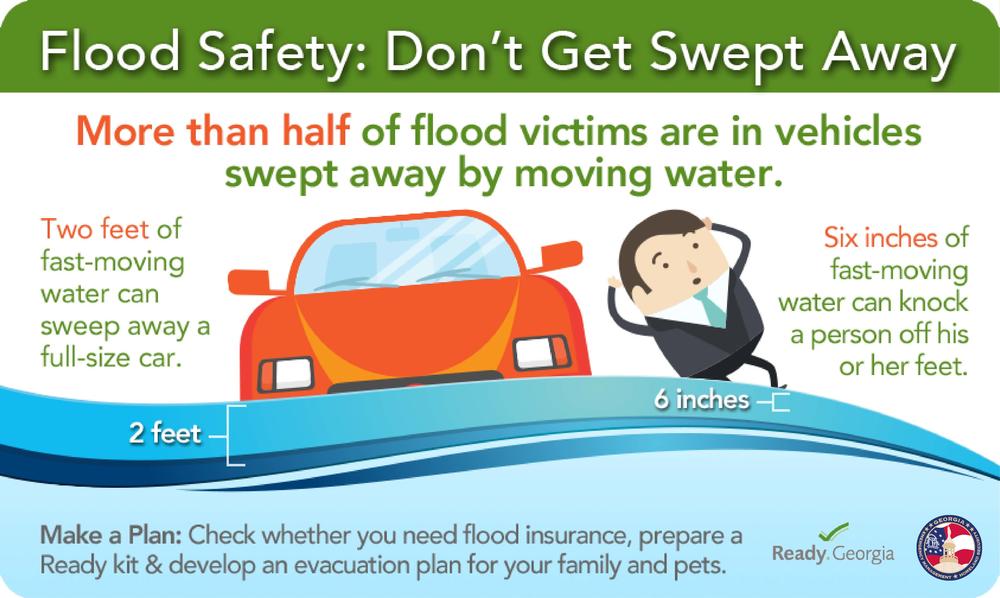
Floods and Flash Floods
Floods can be slow or fast rising, but generally develop over a period of days. Many communities experience some kind of flooding after spring rains or heavy thunderstorms.
Flash floods usually result from intense storms dropping large amounts of rain within a brief period. They occur with little or no warning and can reach full peak in only a few minutes. Communities particularly at risk are those located in low-lying areas, near water, or downstream from a dam.
Georgia has more than 4,600 dams, the majority of which are privately owned. Dam failures can occur with little warning. When a dam fails, the damage can be catastrophic.
Before Flooding
- Know your area’s flood risk – if unsure, call your local emergency management agency or planning and zoning department, or visit Flood Smart.
- Property insurance does not typically cover flood damage. Talk to your insurance provider about your policy and consider if you need additional coverage. The National Flood Insurance Program is designed to provide reasonable flood insurance in exchange for the careful management of flood-prone areas by local communities. The program, administered by FEMA, is available in hundreds of participating Georgia communities.
- Familiarize yourself with the terms that are used to identify a flood.
- A flood watch means widespread flooding is possible in your area. Be prepared to evacuate. A watch is issued for flooding that is expected to occur six to 12 hours after the heavy rains have ended.
- A flood warning means a flood is expected in your area within six to 12 hours. If local authorities advise you to evacuate, do so immediately.
- Get a Ready kit and prepare a portable Ready kit in case you have to evacuate. Plan how you will leave and where you will go if you are advised to evacuate.
- Keep insurance policies, documents, and other valuables in a safe deposit box and keep copies in a waterproof container in your Ready kit.
- Reduce potential flood damage by raising your furnace, water heater and electric panel if they are in areas of your home that may be flooded.
- Move your furniture and valuables to higher floors of your home.
- Your family might not be together when disaster strikes, create a communications plan. Choose a meeting place outside of your neighborhood in case your family is apart and unable to return home due to flooded roads.
- Determine an out-of-town contact. It may be easier to text or call long distance if local phone lines are overloaded or out of service. Everyone should have emergency contact information in writing or programmed into their cell phones.
- Plan ahead for your pets. Shelters cannot accept pets due to health reasons, so it’s important to find a pet-friendly hotel or make arrangements with family or friends in advance.
During Flooding
- If it has been raining hard for several hours, or steadily raining for several days, be alert to the possibility of a flood.
- Closely monitor a local radio station, TV station, NOAA Weather Radio for flood information.
- Follow the instructions of local officials. If advised to evacuate, do so immediately.
- Do not drive around barricades. They are there for your safety.
- NEVER drive through standing water. It only takes one foot to float a full-sized automobile and two feet can sweep it away.
- More than half of flood victims are in vehicles swept away by moving water.
- Move to higher ground away from rivers, streams, creeks and storm drains.
- Stay out of floodwaters if possible. The water may be contaminated or electrically charged. However, if your car stalls in rapidly rising waters, get out immediately and seek higher ground.
- Six inches of fast-moving water can knock a person off his or her feet
- Stay away from downed power lines to avoid the risk of electric shock or electrocution.
Check out our infographic for more tips on what to do when it floods.

After Flooding
- Do not return to your home until local authorities say it is safe. Even after floodwaters recede, roads and bridges may be weakened and could collapse. Buildings may be unstable, and drinking water may be contaminated. Use common sense and exercise caution.